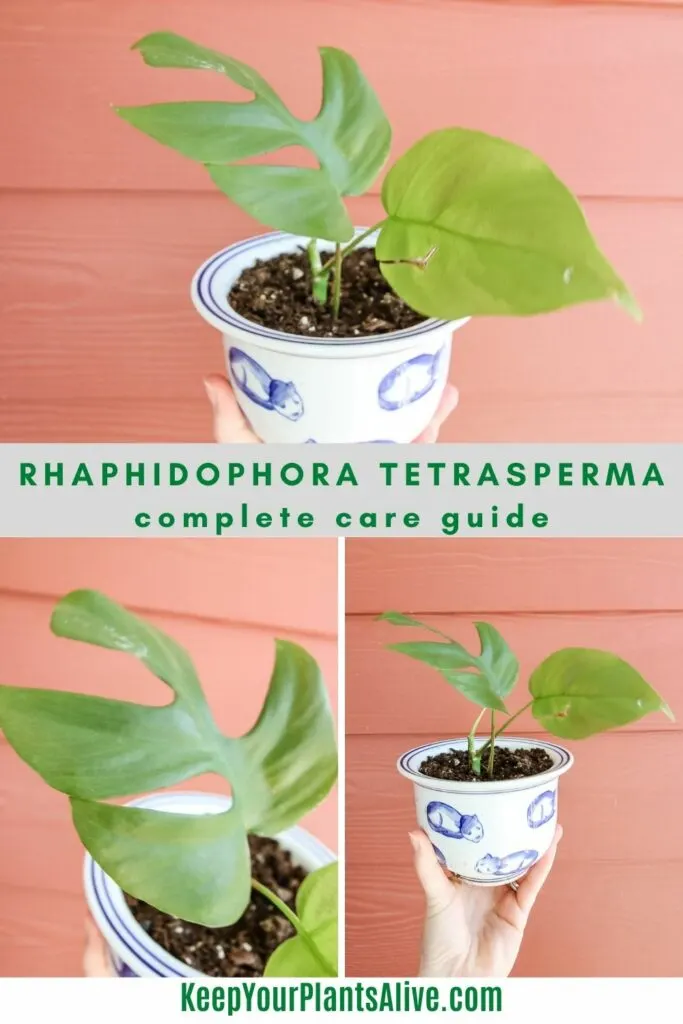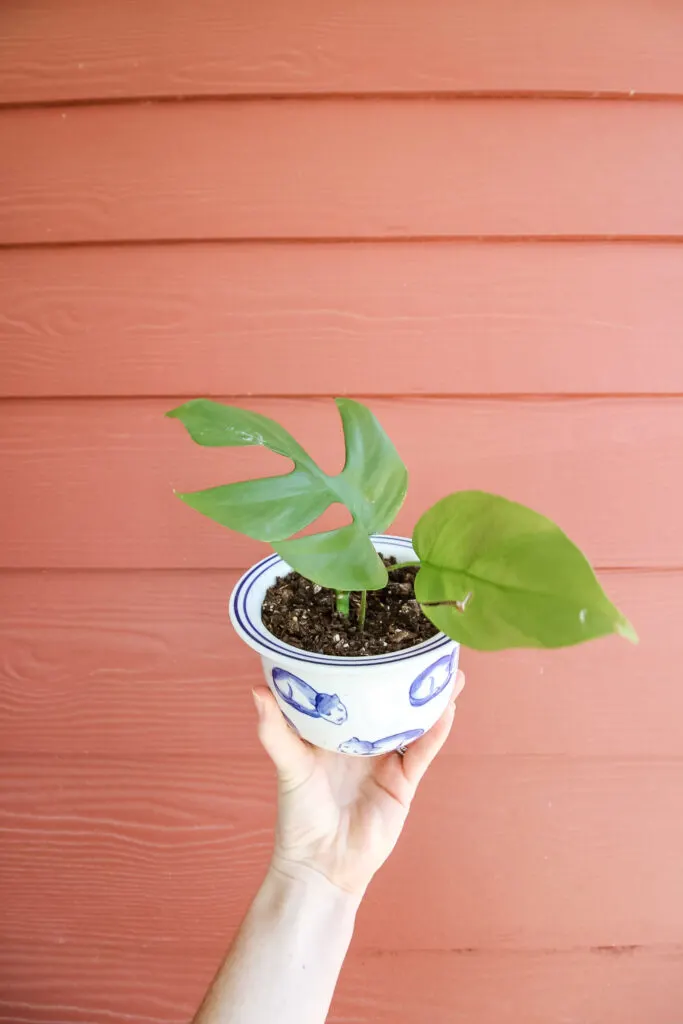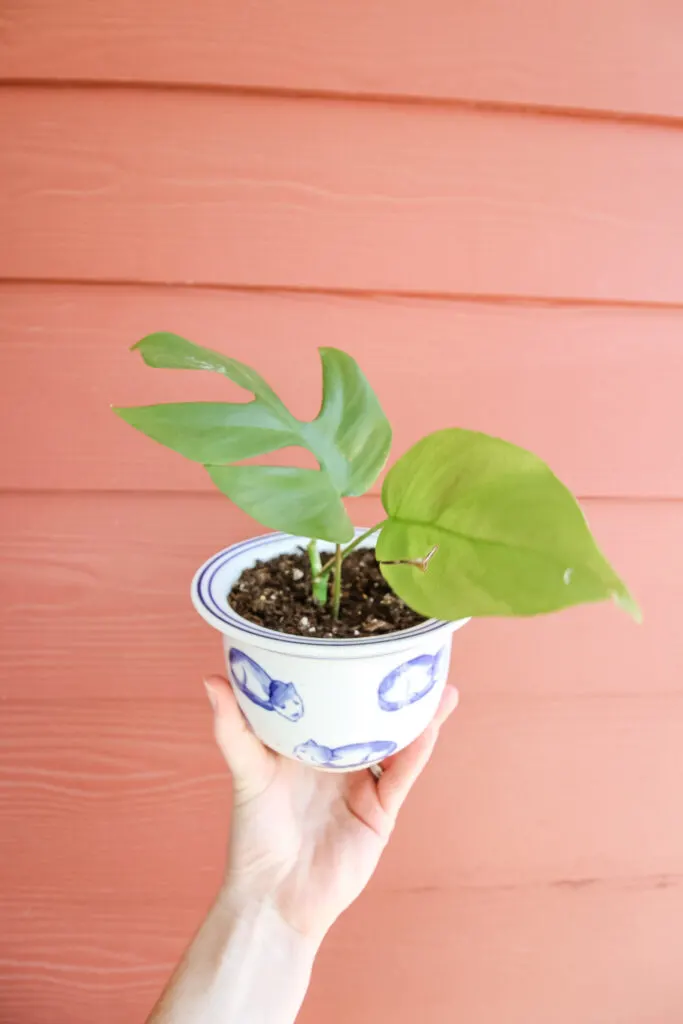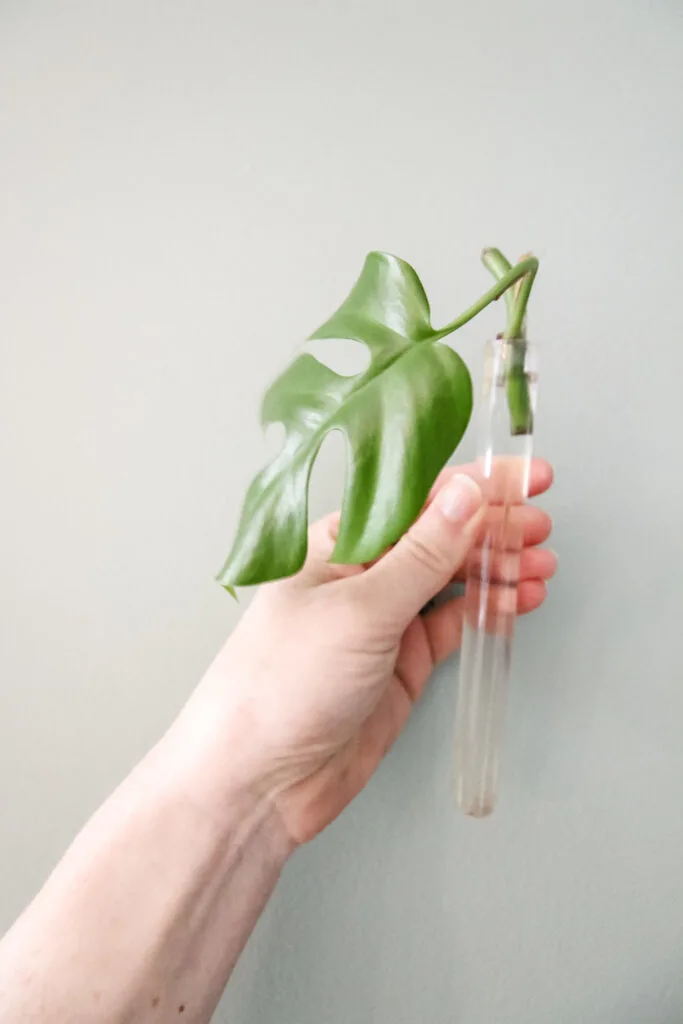Considering adding a Rhaphidophora Tetrasperma to your plant collection? Let’s talk about Rhaphidophora Tetrasperma care and it’s water, lighting, and other needs!
Rhaphidophora Tetrasperma is a vining plant with fenestrated leaves. This plant is commonly known as the “mini monstera plant” for it’s very similar appearance to the monstera. But, these leaves are much smaller on this trailing plant!
Rhaphidophora Tetrasperma is also known as:
- Mini monstera
- Mini split-leaf
- Ginny philodendron
- Monstera ‘Ginny’
- Philodendron Piccolo
- Monstera minima
Is Rhaphidophora tetrasperma rare?
I think that these plants were rare and super desirable in 2020/2021. I haven’t seen one at Lowes, but I do see them at my local plant store plenty.
I actually received mine as a set of 3 cuttings… for free in a swap for some swiss cheese cuttings. So I definitely don’t think they are ultra rare or valuable any more.
Is Rhaphidophora tetrasperma toxic?
Yes, these plants are toxic if ingested for humans and pets. Keep away from curious mouths!
Rhaphidophora tetrasperma vs. monstera deliciosa
– is Rhaphidophora tetrasperma a monstera?
This plant is often referred to as a mini monstera – but it’s not a monstera at all. The leaves just have a similar shape, and monstera is a well known plant. Tetrasperma and monstera deliciosa are a totally different species, with much smaller leaves and it does not produce edible fruit.
Is Rhaphidophora tetrasperma a philodendron?
No, this plant is in the Araceae family and is not a philodendron at all – it just kind of acts like one.
How big do Rhaphidophora tetrasperma leaves get?
These leaves are usually around 4-6″ wide. They are split with beautiful window shaped splits! The vines typically grow to 4 to 5 feet long as potted houseplants.
Do Rhaphidophora tetrasperma grow quickly?
When given the right conditions, these plants will grow really well and really quickly, especially in Spring and Summer! They have been known to grow in bursts and quickly outgrow trellises.

Rhaphidophora Tetrasperma care tips
Is Rhaphidophora tetrasperma easy to care for?
Yes, these plants are easy going and fun to care for! They don’t have any particularly difficult needs and they grow quickly and easily.
Rhaphidophora Tetrasperma watering
This plant likes to remain moist – but not soggy. Use your finger to see if the soil is moist 2 inches down and water if it is not.
Be sure that your pot has drainage holes to prevent pooling water. Pooling water can cut off the oxygen supply to your plant’s roots and cause root rot. Root rot is deadly!

How often should I water Rhaphidophora?
Water your plant when the top two inches of soil feel dry to the touch. This could be less often in cooler months and more often in warmer months.
Warning: if you keep the plant indoors and run a heater, that can dry plants out just like summer heat!
Do Rhaphidophora tetrasperma like to dry out?
No, these tropical plants like consistent moisture. Don’t let them get dry!
Should I mist my Rhaphidophora tetrasperma?
These tropical plants love humidity. Indoors, run a humidifier, use a pebble tray, or mist them daily to create that steamy environment!
Rhaphidophora Tetrasperma lighting needs
These plants love bright, indirect light. The fenestrations in the leaves are actually a way for the leaf to access a wider area of sunlight with the same amount of leaf material. So, they really like to soak up the light!
Keep them out of direct sun, however, or they could get sunburned. Sunburn looks like black or dark brown crispy spots on the leaves. Remember, in the wild they would be below the shade of a big tree.
These plants can survive with slightly lower light, but they will slow down their growing tremendously! Consider a grow light if you don’t have a nice sunny spot for them.

Rhaphidophora Tetrasperma soil + potting needs
Use a well draining soil to avoid pooling water and root rot. Most high quality potting mixes are great, though you can always mix in some peat moss or perlite to improve drainage.
These plants have a tendency to get fertilizer burn, so be careful. Stick to slow release fertilizers in low dosages to avoid the burn!
Don’t put Rhaphidophora Tetrasperma plants in a terra cotta plant – they make the plants dry out too much for their liking.
Does Rhaphidophora Tetrasperma like to be root bound?
These plants do NOT like to be root bound and do best in a slightly larger pot. Repot regularly, especially if you haven’t been seeing much new growth.
Rhaphidophora Tetrasperma trellis needs
In nature, these plants would grow under and up trees. They are vining plants that like something to latch onto with its aerial roots. Consider a bamboo stake, trellis, or moss pole.
Leaves on plants tend to get larger and more fenestrations when allowed to climb and in brighter light.

Can Rhaphidophora Tetrasperma grow outside?
These plants can be grown outside in zones 9b-12. Always bring them indoors if the temperature will drop below 55 degrees.
Rhaphidophora Tetrasperma pruning
You can prune your plant to shape it or remove any dead leaves.
How do you make Rhaphidophora tetrasperma bushy?
The best way to make your plant grow bushier is by pruning it. Cut any leggy long branches and propagate them. The plant will re-focus it’s growth closer in and create new bushy branches.

How to propagate Rhaphidophora Tetrasperma
These plants are super easy to propagate!
- Select a healthy branch, preferably with new growth
- Cut so you are removing at least 1 node from the parent plant
- Place in water
- Watch roots form!
- Once the roots are 2 inches long or have secondary roots growing off the main root (like little forks in the root), plant in potting soil
- Treat like a parent plant
Read my complete guide on how to propagate Rhaphidophora tetrasperma!
Rhaphidophora Tetrasperma troubleshooting
Why is my Rhaphidophora tetrasperma so leggy?
A leggy plant has long strands of stem without many leaves. This indicates that your plant needs more light! Move it to bright light to encourage leaf growth.
However, it isn’t going to go back and grow new leaves on old stem. You are better off cutting and propagating that branch!
Why is my Rhaphidophora tetrasperma leaves not splitting?
The leaves on this plant fenestrate, or split, to reach more light. Low light conditions often causes them to not split. So, move to a sunnier spot, improve their attitude, and they will split in no time!
Your plant also might not have fenestrations if it is super young. Only mature plants split!
If your Rhaphidophora tetrasperma is not fenestrating, try giving it something to climb. Climbing plants tend to get bigger leaves with more splits on them, compared to trailing plants!
Why is my Rhaphidophora tetrasperma turning yellow?
Yellowing leaves usually indicates over watering. Check your pot for pooling water and add drainage holes if needed.
Yellow leaves could also indicate not enough sunlight. Move it to a brighter spot and see if that helps!
Read my complete guide on why is my Rhaphidophora tetrasperma turning yellow!
Why is my Rhaphidophora tetrasperma leaves curling?
Curling leaves almost always indicate that your plant is under watered. If the tetrasperma rhaphidophora soil is very dry or hard to the touch, this might be the case. Remember to keep it constantly moist!
Why is my Rhaphidophora Tetrasperma droopy?
Droopy leaves could mean either too much or too little water. It should be obvious which it is – hard dry soil means under watered, soggy soil means over watered. Adjust your watering schedule to improve it!
Does Rhaphidophora branch?
Yes, you can encourage your plant to branch by taking cuttings and propagating them. It will then branch off at the last node you left on the parent plant!
Is Monstera minima the same as Rhaphidophora?
Yes – these are two common names for the same plant!
Any more questions about Rhaphidophora tetrasperma care?
Thanks for reading!


Hey there, I’m Morgan, a houseplant enthusiast from sunny Charleston, South Carolina. Growing up surrounded by my mom’s lush orchids and African violets, I discovered the magic of bringing nature indoors. Thanks to the pandemic, I delved deeper into houseplants, discovering their power to uplift moods and transform spaces. I’m here to spill all my secrets, helping you pick the perfect houseplant – and make it happy. Let’s keep your plants alive, together! 😊
